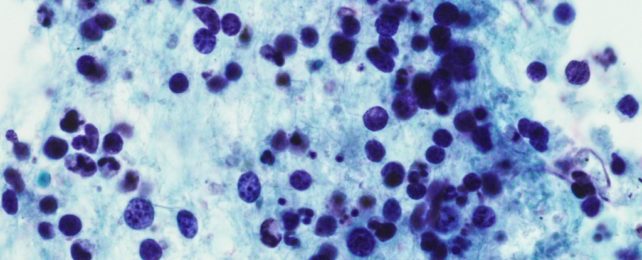Through an experimental combination of two drugs, scientists have been able to effectively halt the progress of small cell lung cancer – a deadly form of lung cancer – in tests on mice. Now, off the back of those promising results, human trials are planned.
One of the drugs, cyclophosphamide, has been relatively unused to treat small cell lung cancer since the 1980s, when it was replaced with alternatives that had fewer side effects.
However, whether cyclophosphamide or the alternatives are used, the cancer quickly develops resistance to the treatment.
Now, the team behind the new experiments has been able to identify how small cell lung cancer cells resist the effects of cyclophosphamide – and do something about it.
The technique they've developed essentially blocks the repair process that the cancer cells use to build up cyclophosphamide resistance.
"The problem is that these tumors respond to treatment initially, but then they come back. This has not changed for 30 years," says pathologist and immunologist Nima Mosammaparast from Washington University in St Louis.
"These tumors are just massively resistant to just about everything."
The new findings build on previous research from the same team that identified the protein RNF113A as being involved in cancer cell repair – specifically, in the repair of a type of DNA damage known as alkylation damage, the kind caused by cyclophosphamide.
Further research revealed that RNF113A is regulated by SMYD3, a protein highly expressed in small cell lung cancer and found in higher levels in more invasive forms of the disease. Elevated levels are also associated with increased resistance to alkylating chemotherapy drugs (the category that includes cyclophosphamide) and a worse overall prognosis.
In contrast, healthy lung tissue has very low levels of SMYD3.
Armed with that knowledge, the researchers tried to target SMYD3 in mice in which the team had grafted human lung tumors – some of which had already been treated with chemotherapy, and others that had not.
While cyclophosphamide temporarily worked on its own, and an SMYD3 inhibitor slowed down tumor growth to some extent, it was only when the two treatments were combined that the cancer stopped growing completely.
This tumor suppression lasted for the duration of the experiment (roughly a month), well after other single treatments had failed.
"What this study shows is that we can actually combine a new target with an old drug to reduce resistance and potentially make the treatment much better and give these patients a much better chance," says Mosammaparast.
It's still early days – not least because this has only been tested in mice – and scientists want to experiment further to see if they can reduce the level of cyclophosphamide involved to limit the toxic side effects that meant it stopped being used originally.
What's clear though is that the drugs that replaced cyclophosphamide aren't any better at fighting off small cell lung cancer, even if they're less damaging to the body. Current treatment options can only add around two to six months of life.
Now the researchers are looking into getting phase 1 clinical trials in humans organized. One of the promising aspects to come out of the research is that it shows signs that it could work on cancers that have already become resistant to some treatments.
"One of the challenges we will face is convincing doctors to go back to an old drug," says Mosammaparast. "But the nice thing about this strategy is that it may work where current therapies have failed."
The research has been published in Cancer Discovery.
